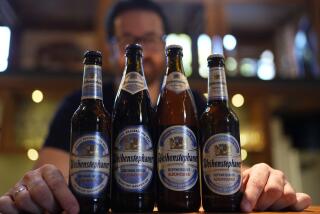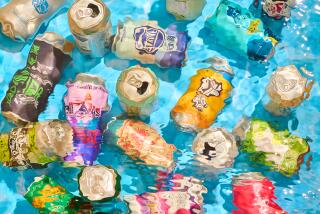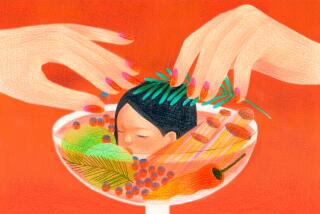A Guide for Aspiring Hop Heads
- Share via
In America, “beer” refers to both ale and lager. You can regard these as distinct families, divided by the type of yeast and the temperature and length of aging. Lagers are aged longer and at refrigerated temperatures. Often they are golden in color and usually are more refined in taste--but sometimes not. Ales are aged at cellar temperatures and often are coppery to very dark in color. Ales tend to have more “character,” although that, too, is a generalization.
Apart from that, beer is basically the play of two elements--malt and hops (or in some beers, fruit). Malt makes the body, hops the finish. Malt flavors and malt sweetness in beer come from roasted barley grains. The darker the roast and the more malt used in the beer, the more pronounced the flavor. Hops provide spice and herb flavors and bitterness. The variety and the quantity of the hops used determine the outcome. Yeast and water also are important to flavor, but in these matters most consumers must trust the brewer.
So where does one begin?
First, relax. Beer geeks pride themselves on conduct opposite that of wine snobs. Doubts, confusion, wonder--these are expected and encouraged reactions when confronted with strange labels. When you visit a pub, ask for a “taster” before you order. I do it every time. Even when I know what I want, I try a sip of something new. How else can you get through all the fresh “seasonal” offerings?
Recently, a famed Portland microbrewery began serving an oddly named “I Didn’t Inhale Ale.” It seems a brewer forgot to add one ingredient to a standard recipe. Rather than throw out the batch, the brewer just added a whimsical name and let people sample it.
Let’s dispel one myth: There is no relationship between the alcohol strength of a beer and its color. Brown ale, by tradition, is very low in alcohol and meant to be drunk in quantity; hence its nickname, mild ale. An India Pale Ale, on the other hand, is lighter in color, usually blondish, but stronger in alcohol and hops--a “bigger” beer.
Many of today’s craft beers are “bottle conditioned,” meaning that the beer is bottled with live yeast. The addition of sugar just before capping triggers more fermentation, which adds natural carbonation. This process leaves sediment in the bottle.
Some of today’s leading beer experts recognize about 30 styles of beer. The following are guidelines to a few of the domestic styles now commonly found. They are apt to be as wrong as right, depending on the brewer. But they offer a starting place:
* Lager: Also called light lager, this is the style of most commonly known national brands, such as Budweiser. Lagers are generally crisp, have lower taste profiles and are not infused with much bitter hop flavor. Many economy lagers are made with rice as well as barley malt. Pilsners and pils are lagers, and sometimes they are distinctly hopped.
* Pale ales: Pale ales generally are not so pale but more coppery in color. This style has a vast range of tastes. Compared to light lagers, these beers have a higher flavor profile and more hops. They sometimes are described as having “fruity” notes, although these are quite different from those found in fruit beer. Other label descriptions commonly used are “bitter” or “extra bitter.” Ales that are labeled “dry hopped” have been given an extra helping of hops at the end of the cooking process and are exceedingly hoppy or bitter; they are favorites of “hop heads.”
* India pale ales: Stronger versions of the above. Often vigorously hopped.
* Amber and red ales: Compared to pale ales, they are generally darker and sweeter and often less bitter. Together, these ales and the pales comprise the heart of the microbrewing revolution.
* Scotch ales: They are stronger versions of the above, often almost syrupy.
* Wheat ales, hefeweizen or weissbiers: Made partially with wheat grain and with unique yeasts, these are generally “smaller” beers known for their tartness or spiciness. Often these are served unfiltered and appear cloudy thanks to suspended yeast. Many of today’s microbrew fanciers began by tasting a good wheat beer.
* Fruit beers: Sometimes these beers are subtle and suggestive, other times as shockingly sweet as soda pop. Some are fermented with fruit and others simply flavored with fruit syrup. The only rule I know is that there are no rules here. Ask for a sample taster every chance you get.
* Bock and dopplebock lagers: These are dark and malty beers brewed in the lager style--strong in flavor and character. Some are noticeably hopped.
* Brown ale, porter and stout: These styles describe, one-two-three, the scale of color and body of dark, malty ales. Colors climb the scale from brown to black. Usually, they have distinct caramel and roasted notes. Typically these beers are not so highly carbonated as lagers and lighter ales. Many are low in alcohol.


